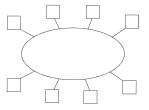 Common Signaling Schemes
Common Signaling Schemes Common Signaling Schemes
Common Signaling Schemes
In the early nineties, there were several competing Signaling Schemes for how to put data packets onto cabling or fiber. The most common were Ethernet, Token Ring, ARCNet, and LocalTalk. Late comers to the fray were FDDI and ATM. All these signaling schemes lost out, over time, to Ethernet, with the exception of ATM, and mostly in regard to Wide Area Network connectivity (i.e., how an ISP connects very large LANs to the Internet).
 Token Ring technology represented the most serious threat,
but was defeated by its own expensive, proprietary licensing arrangements,
similar to how BetaMax lost out to VHS in the early 80's VCR format war.
Token Ring signaling involves placing a token on a transmission media (usually
in a LAN setting using Unshielded Twisted Pair, or UTP). The Token is
placed on the media and passed along. Each PC politely waits its turn to
receive the token when it's not busy with a previous request, thereby
eliminating the possibility of collision or the need to re-transmit, like shared
Ethernet.
So in a non-switched environment, Token Ring had some technical advantages over
Ethernet.
Token Ring did help to institute Star topology.
Token Ring technology represented the most serious threat,
but was defeated by its own expensive, proprietary licensing arrangements,
similar to how BetaMax lost out to VHS in the early 80's VCR format war.
Token Ring signaling involves placing a token on a transmission media (usually
in a LAN setting using Unshielded Twisted Pair, or UTP). The Token is
placed on the media and passed along. Each PC politely waits its turn to
receive the token when it's not busy with a previous request, thereby
eliminating the possibility of collision or the need to re-transmit, like shared
Ethernet.
So in a non-switched environment, Token Ring had some technical advantages over
Ethernet.
Token Ring did help to institute Star topology.
 Being a bus, Ethernet was conventionally deployed at the
beginning of the 1990's using hair-brained topologies like coaxial
cabling. Token Ring was most commonly deployed using UTP with individually
terminated lines coming back to a central concentrator, or MAU. Although
via hubs, this cabling topology was eventually adopted for Ethernet, too, the
networking world does owe a debt of gratitude for Token Ring being implemented
in a logical, more stable configuration.
Being a bus, Ethernet was conventionally deployed at the
beginning of the 1990's using hair-brained topologies like coaxial
cabling. Token Ring was most commonly deployed using UTP with individually
terminated lines coming back to a central concentrator, or MAU. Although
via hubs, this cabling topology was eventually adopted for Ethernet, too, the
networking world does owe a debt of gratitude for Token Ring being implemented
in a logical, more stable configuration.
ARCNet was a proprietary technology created by DataPoint that, though initially very inexpensive, never made it out of its market share slice as a slower alternative to Ethernet in Novell NetWare settings. LocalTalk was a very easy to set up, but hopelessly slow (less than 256 kilobit/second transmission rate) technology that Apple Computer put into all Macintoshes in the 1980's.
FDDI was often called "Token Ring done right." It remained the high-end alternative to Token Ring, until 100 Mb/sec Ethernet, and especially switched 100 Mb/sec Ethernet eliminated its speed advantages.
ATM has always been very difficult to set up and maintain. It uses cell technology, as opposed to packets, and is the primary standard for shipping data over the Internet by the Public Telephone Network (via AT&T, Sprint & MCI). In LAN settings, however, ATM's primary advantages were overcome by 100 Mb/sec Ethernet and especially 1000 Mb/sec Ethernet.